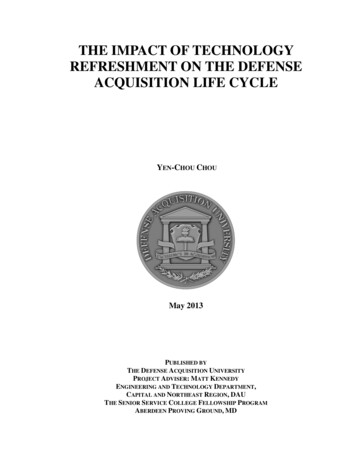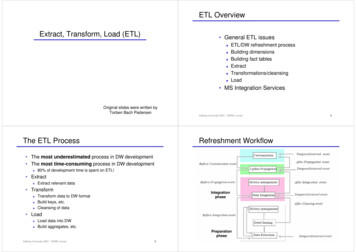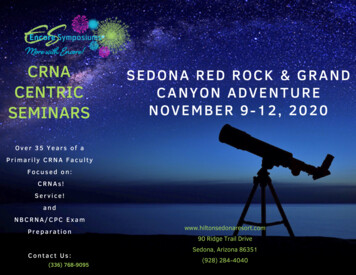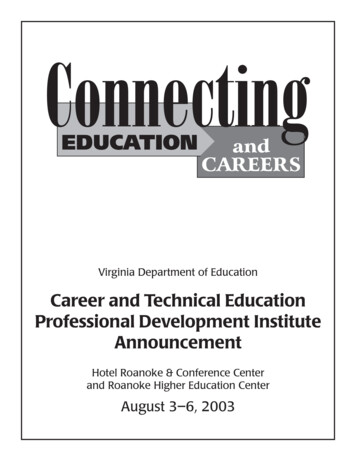
Transcription
THE IMPACT OF TECHNOLOGYREFRESHMENT ON THE DEFENSEACQUISITION LIFE CYCLEYEN-CHOU CHOUMay 2013PUBLISHED BYTHE DEFENSE ACQUISITION UNIVERSITYPROJECT ADVISER: MATT KENNEDYENGINEERING AND TECHNOLOGY DEPARTMENT,CAPITAL AND NORTHEAST REGION, DAUTHE SENIOR SERVICE COLLEGE FELLOWSHIP PROGRAMABERDEEN PROVING GROUND, MD
PAGELEFTBLANKINTENTIONALLY
THE IMPACT OF TECHNOLOGYREFRESHMENT ON THE DEFENSEACQUISITION LIFE CYCLEYEN-CHOU CHOUMay 2013PUBLISHED BYTHE DEFENSE ACQUISITION UNIVERSITYPROJECT ADVISER: MATT KENNEDYENGINEERING AND TECHNOLOGY DEPARTMENT,CAPITAL AND NORTHEAST REGION, DAUTHE SENIOR SERVICE COLLEGE FELLOWSHIP PROGRAMABERDEEN PROVING GROUND, MD
PAGELEFTBLANKINTENTIONALLYii
Table of ContentsTable of Contents . iiiList of Figures . viList of Tables . viAbstract . viiAcknowledgments . ixChapter 1—Introduction . 1Background . 2Tech Refresh (TR). 2Technology Insertion (TI) . 3Technology Transition (TT) . 5Agile Process . 6Technology Readiness Levels (TRLs). . 7Problem Statement . 9Purpose of This Study . 9Significance of This Research . 9Overview of the Research Methodology. 10Research Questions . 10Limitations of the Study . 10Validity of the Research . 10Reliability of the Responses . 11Chapter 2—Literature Review . 13Research Project Requirements. 13iii
General Discussion . 13DoD Instruction 5000.2 . 13Army Acquisition Policy, Army Regulation (AR) 70–1 . 13DoD and Army Guidance . 14Senior Leader Thoughts on Tech Refresh . 14Defense Acquisition University. 15Rationales for Technology Refresh . 16Acquisition Process and Programmatic Considerations. 17Architectural Considerations . 17Planning Considerations . 18Performance Based Logistics Strategy . 19Contracting Considerations . 19Budgeting Considerations . 20System Engineering Process and Life Cycle Support . 21Challenge for Program Managers . 23Acquisition Phases . 24Coordination . 25Commercial Off The Shelf . 25Enablers of Tech Refresh . 26Summary of the Literature Review . 28Chapter 3—Research Methodology. 29Research Process . 29Data Collection . 29iv
How Will the Data be Collected?. 30Chapter 4—Findings . 31Case Studies . 31Case 1: AN/TSC-93E . 31Case 2: Migration of a Knowledge Management Tool. . 35Summary of the Case . 39Population and Sample Size . 40Collected Data . 41Section 1: Previous Experience with Tech Refresh. 41Section 2: Opinions on Tech Refresh . 41Section 3: Acquisition Process . 50Chapter 5—Conclusions and Recommendations . 61References . 63Glossary of Acronyms and Terms . 67Appendix A—Demographics of the Respondents . 71Appendix B—Written Comments on Some Questions . 77Author Biography . 889v
List of FiguresFigure 1. Optimal Phase to Plan for Tech Refresh . 42Figure 2. Optimal Phase to Start Tech Refresh. 43Figure 3. Reasons for Tech Refresh . 44Figure 4. Sources for Tech Refresh . 45Figure 5. Importance of Tech Refresh Planning . 46Figure 6. What Should be Considered When Planning for Tech Refresh? . 47Figure 7. Who Should be Involved in Tech Refresh Planning? . 48Figure 8. Should COTS be Modified to Suit Program Needs? . 55Figure 9. How Was a Decision to Stop Older Release Made? . 56List of TablesTable 1. Definitions of Technology Insertion, Refreshment, Transfer, and Transition. 6Table 2. Cost Savings Due to Tech Refresh . 35Table 3. Sample Size. 71vi
AbstractIn this paper, we will define what technology refreshment (or tech refresh) is in theDepartment of Defense (DoD) acquisition context. We will show the awareness of the acquisitioncommunity on this subject and assess the sentiment of the community toward the acquisitionprocess with respect to tech refresh, and, in particular, the adequacy of the acquisition process indealing with rapid advancement in Information Technology (IT) and Commercial Off The Shelf(COTS) tools.vii
viii
AcknowledgmentsThe author would like to thank his research advisor Professor Matthew R. Kennedy forproviding his guidance and help throughout the research. He would also like to thank his mentor,Ms. Jill Smith, Director, Communications-Electronics Research, Development and EngineeringCenter, for suggesting this research topic and for her mentoring, encouragement and guidanceduring Senior Service College Fellowship (SSCF) program. The author also would like to thankthe 2012 SSCF cohort in Aberdeen Proving Ground (APG), MD, who made the study enjoyable aswell as mentally and psychologically challenging. Special thanks go to Ms. Lydia L. Yowell, whokindly provided help on designing the survey questions and gathering the result, among muchother assistance and friendship. Also greatly appreciated are those who kindly provided theirexperience, knowledge, and opinions by completing the survey. Last but not least, the authorwould like to thank his wife, Chang, and his two daughters, Yi-Shuan and Yi-Shi Cynthia, for theirlove, encouragement, and support during his tenure at SSCF and his career.ix
x
Chapter 1—IntroductionIn almost all acquisition programs, especially for the major weapon systems or MajorAutomated Information Systems (MAIS), the development cycles may take 10 years or longer(Harp, 2009). The average time to deliver an initial DoD program capability is 91 months,according to a Defense Science Board analysis of 32 major information system acquisitions(Takai, 2012). It is difficult to keep pace with user needs and technology evolution; therefore, it isimportant to have a mechanism to eliminate obsolescence at the time of delivery. Afterdeployment, these systems may be in service for much longer time (Donley, 2011). During thesetimes, there will be rapid advancement in the underlying technologies, such as in computingprocessors, IT, or electronic devices, as witnessed in the past few decades. Furthermore,obsolescence of underlying technologies or components becomes a more pressing issue for theprogram managers (PMs). There is a need to understand what would be an appropriate time toinsert the new technology into the acquisition life cycle, and what the supporting mechanisms areand any programmatic concerns that need to be addressed for successful management oftechnology refreshment (or tech refresh).The research has three major goals:1.Evaluate awareness of the acquisition community on tech refresh.2.Assess the sentiment of the community toward the acquisition process with respect totech refresh.3.Determine the adequacy of the acquisition process in dealing with rapid advancementin IT and COTS tools.We will show what the acquisition community knows about tech refresh and theirexperiences in dealing with tech refresh. We will analyze if the acquisition community feels thatthe acquisition process can or cannot support tech refresh effort adequately. Since IT and software1
play important roles in our weapon and business systems, we will show how the community feelsabout the process with respect to its dealing with rapid advancement in IT.As part of literature review, we will show the definition of tech refresh from the DoDregulations and policies, the purposes for tech refresh, the requirements for tech refresh asmandated by regulations, policies or resources perspectives, or recommendations, guidance fromsimilar sources. We show the guidelines or supports for anyone involved in tech refresh, thechallenges PMs or acquisition personnel face and how they can deal with these challenges withrespects to managing tech refresh.BackgroundWhen performing literature review, it was found that terms such as technologyrefreshment, technology transfer, technology transition, and technology insertion tend to be usedinterchangeably and therefore it would be important to define them and make a clear distinction(when applicable) for the purpose of this research. Before we dig into the details, a subtle butimportant feature that makes tech refresh different from others is that tech refresh is to be done“periodically” and “incrementally.” This continuity of effort does not appear in the definitions ofother terms. It suffices to say that since the advancement of technology is rapid and continuous, itshould not be one time effort for the other cases either. Maturity of the technology involvedrequires a considerable planning and management effort, especially for tech transition.Tech Refresh (TR)The definition of tech refresh from DoD Instruction (DoDI) 5000.02:Definition of Technology refreshment (or tech refresh)Technology Refresh (TR) is defined as the periodic replacement of both custombuilt and Commercial-Off-The-Shelf (COTS) system components, within a largerDoD weapon system, to assure continued supportability throughout its lifecycle.2
Another definition of tech refresh found from Integrated Product Support (IPS) ElementGuidebook:Continuous technology refreshment is the intentional, incremental insertion of newertechnology into existing systems to improve reliability, and maintainability, or reduce costtypically in conjunction with normal maintenance.This definition shows that tech refresh is done incrementally, continuously and usually inconjunction with normal maintenance. Being intentional requires deliberate planning for resources,schedule and reliability, maintainability considerations by the program management office. Itshould be noted that in this definition tech refresh is typically done in conjunction with normalmaintenance.Technology Insertion (TI)Technology Insertion is defined as “a change that incorporates a new product or functionalcapability, which is the result of industry growth or DoD advanced development (Haines, 2001).An alternative definition for TI is “the utilization of a new or improved technology in an existingproduct” (Kerr, 2008). Stocker further elaborated that “TI refers to the “refreshment” and“enhancement” of system performance and functionality in existing or deployed defense systemsby the utilization of a new or improved technology” (Stocker, 2010). From this definition anddiscussion below from discovery of related DoD source, in this paper, we make no distinctionbetween TR and TI.DoD 7000.14-R does not differentiate between technology refreshment with insertion andmodifications stating that “continuous technology refreshment is the intentional, incrementalinsertion of newer technology to improve reliability, improve maintainability, reduce cost, and/oradd minor performance enhancement, typically in conjunction with depot or field levelmaintenance” (DoD 7000.14-R). Sue C. Payton, the Deputy Under Secretary of Defense3
(Advanced Systems and Concepts) had published on a paper on nine technology insertionprograms that can speed acquisition (Payton, 2006). There was no formal definition of technologyinsertion there, but she advocated that “the Department of Defense must innovate faster than everbefore because our adversaries have equal opportunities. To meet this challenge, severaltechnology insertion processes have been consolidated at the Office of the Secretary of Defense,and they can do a lot to speed acquisition.” She also indicated that in the recent years, the threatswere rapidly evolving and thus created for the needs to rapidly evolving technologies thatexceeded our capability to insert those technologies supported by our processes. She cautioned thatwhen introducing technology, our focus should be on mature technologies instead of less provenones that often delay schedules and drive up costs. She quoted the words of Acting DeputySecretary of Defense and Secretary of the Navy Gordon England, “The greater institutional risk forDoD is overreliance on traditional platforms and delaying the advent of new technologies andsystems”. The nine technology insertion programs mentioned in her paper included:1.Using R&D [Research and Development] That Already Has Been Done under theIndependent Research and Development Program2.Using World-class Developments taking advantage of the Foreign Comparative TestingProgram3.Moving Key Technologies out of Labs Faster with the Technology Transition Initiative4.Achieving Milestone B Faster under the Advanced Concept Technology DemonstrationProgram5.Accelerating Joint Capabilities with the Joint Capabilities Technology DemonstrationProgram6.Speeding DoD Technology to Private Sector Manufacturers with the TechnologyTransfer Program7.Faster, Better, and Cheaper Manufacturing by the ManTech Program8.Speeding Production of Critical Technologies with Defense Production Act Title IIIProgram4
9.An On-Ramp for Industry Innovation using the Defense Acquisition ChallengeProgramIt is clear that her idea of TI is a big umbrella under which the DoD acquisition processescan benefit from all sources and that evolving technologies can be provided faster than dictated bythe current process. Tech transition, technology transfer, foreign or Science and Technology(S&T) sources, private sectors, are all included as tech insertion efforts.Technology Transition (TT)In the Manager’s Guide to Technology Transition in an Evolutionary AcquisitionEnvironment, Ms. Payton and Frank Anderson, Jr., president of DAU, stated that an importantinitiative is to get the latest technology into the hands of the warfighters in the quickest, most costeffective manner possible [DAU, 2005]. TT is defined as “the use of technology in militarysystems to create effective weapons and support system—in the quantity and quality needed bywarfighters to carry out assigned mission at the “best values” as measured by the warfighters.” TTcan occur during the development of systems or after the deployment of the systems. The guidedoes not provide any differentiation between TT and TR. It provides the following advice to theAcquisition, R&D, and Sustainment Communities: “no matter whether your system uses defenseunique technology or commercially technology, your program must be designed to keep pace withthe rapid cycle of the commercially available technology, changes and obsolescence will becontinual. The way to deal with these changes and obsolescence is to design for them, plan for,budget for, and have a technology refreshment programs in place so improvements in bothcapability and affordability can be incorporated throughout the useful life of the system.” Therealso are considerations for putting incentives in the contract for continuously inserting andrefreshing value-added technology. Regular upgrades using tech refresh are encouraged instead ofmajor end-of-life modification or a follow-on system also is advised. Tech refresh can help the5
sustainment community to improve weapon system reliability, maintainability, and supportabilityand maintain long-term competitive pressures (to the vendors).Here we summarize the definitions of technology insertion, technology refreshment,technology transfer, and technology transition in the table below:Table 1. Definitions of Technology Insertion, Refreshment, Transfer, and TechnologyTransferTechnologyTransitionA change that incorporates a new product or function capability, which is theresult of industry growth or DoD advanced development. Alternatively, it isdefined as the process of incorporating and exploiting new or improvedtechnology into existing platforms, systems, and equipment.The periodic replacement of commercial off-the-shelf (COTS) components withinlarger systems to assure continued supportability of the system through anindefinite service life. Alternatively, it can be defined as a strategy to providecost-effective support and upgrade strategies, to keep a programahead of the obsolescence curve. This strategy should result in regular upgradesinstead of major end-of-life modifications or follow-on systems.Technology transfer is the process of sharing knowledge gained in federallaboratories with the private sector, generally to encourage new commercialmarkets and applications.The process of applying critical technology in military systems to provide aneffective weapons and support system—in the quantity and quality needed by thewarfighter to carry out assigned missions and at the “best value” as measuredby the warfighter.When discussing and trying to understand tech refresh, the author found out that there were severalconcepts that may be useful to form the basis for dealing with tech refresh. They are discussed asfollows:Agile ProcessAgility in system acquisition has been a hot topic among the research and acquisitioncommunities. The agile process used in the Network Integration Evaluation (NIE) has been theguiding principle for the semiannual integration and evaluation effort. In providing the rationalefor agility in the system development, the author argued that “the need to rapidly field system hasnever been more important” due to the fast-paced nature of technology (Kennedy & Ward, 2012).6
Well-defined requirements alone are not sufficient for the success of any acquisition program, butthe ability to respond to change during development, deployment, and after deployment is equallyimportant. Otherwise, the system may become obsolete even before it is fielded, the authorcautioned. As quoted in the paper, the March 2009 Report of the Defense Science Board (DSB)Task Force on Department of Defense Policies and Procedures for the Acquisition of InformationTechnology concluded that “the conventional DoD acquisition process is too long and toocumbersome to fit the needs of the many IT systems that require continuous changes andupgrades” (DSB, 2009). In a research paper for the Army War College on Moral Imperative forChange when he studied the Army’s failed programs, LTC William Robare indicated it isparamount to focus on the speed at which we develop and deliver the capabilities that thewarfighter require on the battlefield (Robare, 2011).Technology Readiness Levels (TRLs)Payne mentioned that when inserting technology the focus should be on mature technologyto reduce the risk of a negative cost and schedule impact if unproven technologies are used (Payne,2006). A well-known concept of TRL measures the maturity of technology. The acquisitionpolicies require a minimum of TRL 7 (“system prototype demonstrated in an operationalenvironment”) for a critical technology to be incorporated into a production program (an importantbest practice recommended by the Government Accountability Office (GAO) to control technicalrisk, and strongly supported by DoD). On the other hand, expectations for the S&T communityhave traditionally been to advance new technologies only to the TRL 5 level of maturity(“component and/or breadboard validation in a relevant environment” [e.g., high-fidelitylaboratory]). The gap or chasm between the DoD S&T (TRL 5) and acquisition (TRL 7)communities, commonly referred to as the “valley of death,” illustrates the challenge for tech7
transition and needs to be bridged through cooperative efforts and investments by bothcommunities.In Department of Defense Report to Congress on Technology Transition (DoD, 2007), fourbroad areas for improvement were recommended (paraphrased here):1. S&T community “pushes technology” by having early and frequent collaborationbetween the developer, acquirer and user for “technology push.” Technical issues,resource requirements/sources, avoiding unintended consequences, and ultimatelygaining the most yield for the S&T investment can be identified in this effort.2. PM “pulls” technology by conducting early and frequent communication with thedeveloper about user requirements and companion acquisition plans requirements,resources, and acquisition strategies for timely technology transition (“acquisitionpull”).3. Include innovators from the private sector and eliminate technical, cultural, andbusiness barriers to integrating new suppliers and new technologies into defense systemarchitectures. The pace at which new technologies are discovered, innovated,developed, and deployed in the private sector is staggering, and at odds with the linear,deliberate nature of some military acquisitions.4. Use a federated approach to coordinate agile acquisition efforts, look for unrealizedsynergies among transition programs, and ensure adequate resourcing.The report provided a synopsis of the challenges reported by the military departments anddefense agencies for technology transition, including Organizational and Culture Barriers,Acquisition Regulations, and Technology Transition’s Role in the Planning, Programming,Budgeting, and Execution (PPBE) System. For each challenge area, considerations weresuggested. For example, to address organizational barrier, it was suggested that “mechanisms areneeded that continually train and motivate the S&T and acquisition communities to work togetherto reach a common outcome.” The communities need a clear understanding of requirements,needs, S&T, acquisition, supportability, statutory/regulatory guidance, and resourcing methods.8
For acquisition regulation challenge, it is recommended that “an amendment for a ‘bridge’between the end of the basic research portion of a contract award under a Broad AgencyAnnouncement (BAA) and the award of a contract under a new acquisition for advanced researchor production could fill the void created by the existing contracting regulations.” For PPBE issues,there may be needed “a business process to provide gap funding to sustain technology effort untilthe next budget cycle in which obligation and disbursement rates would not be cause forreprogramming.” These challenges and considerations should be equally applicable to tech refresheffort.Problem StatementRapid advancement of technology coupled with long development and service life of theweapons systems pose challenges to the acquisition community in the tech refresh planning effort.Purpose of This StudyThe purposes of this study are to assess the awareness of the acquisition community ontech refresh, assess the sentiment of the community for the acquisition process with respect to thesupport of tech refresh, and assess if the current acquisition process adequately addresses techrefresh effort, especially for IT and COTS.Significance of This ResearchThe rapid advancement of technologies in the past few decades causes the underlyingtechnologies used in the weapon systems or information systems to become obsolete and unable toaddress the ever-evolving threats. Given the long development time and service life of weaponsystems and MAIS, it is important for the acquisition community to gain a better understanding ofthe issues and planning of tech refresh to avoid obsolescence and meet the new threats.9
Overview of the Research MethodologyThe research was guided by conducting a literature review that evaluated federal laws,DoD and Army regulations or guidelines, Defense Acquisition University (DAU) resources,Webster University libraries, and various acquisition and research publications related to techrefresh. Then a survey consisting of questions designed to draw answers to the research questionswas sent out to the acquisition and S&T communities at Aberdeen Proving Ground, MD. Thesurvey results then were analyzed and summarized to see if the research questions were addressed.The research was augmented by two case studies on tech refresh to compare and contrast thesurvey results with operational programs.Research QuestionsIn this research, the author attempts to address the following:1.Evaluate
the impact of technology refreshment on the defense acquisition life cycle . yen-chou chou. may 2013 . publish










